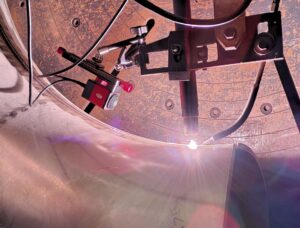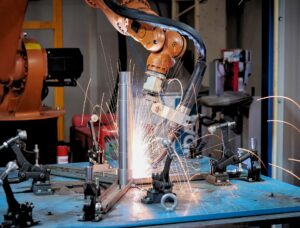In this blog, we’ll explore automated welding in the nuclear sector and how the combination of robotics with advanced camera systems is revolutionizing safety and precision in the industry’s most demanding applications. The nuclear industry operates under the strictest safety and quality standards of any sector. When the structural integrity of welds has life-or-death implications, there is zero margin for error. That’s why the nuclear sector is increasingly turning to automated welding systems—enhanced by advanced welding cameras—to meet these exacting demands. By combining robotics with real-time visual monitoring, facilities can achieve safer, more consistent, and more traceable welds, especially in high-risk and hard-to-access areas.
Why Automation Is Essential in Nuclear Welding
Welds in nuclear facilities aren’t just joining metal—they’re sealing containment systems, pipelines, reactor components, and pressure vessels that operate under intense heat, pressure, and radiation.
Manual welding, while still vital in some areas, faces major limitations:
- Human error in technique or interpretation
- Radiation exposure risks
- Restricted space access
- Fatigue from repetitive or long welds
Automated weld monitoring system, guided by real-time camera feeds, eliminate these risks while boosting repeatability and weld quality.
The Role of Welding Cameras in Automation
Advanced welding cameras play a critical role in making automated welding accurate, responsive, and safe.
These systems provide:
- Data for post-weld analysis and traceability
- Live arc monitoring for weld pool observation
- Closed-loop feedback to the robot for self-correction
- Image capture for inspection and documentation
- Remote viewing in radiation-restricted zones
How It Works: The Tech Behind the Process
- Robot Arm or Gantry System
- The welding head is mounted on a robotic arm or automated track system, pre-programmed with path data.
- Integrated Welding Camera
- Positioned near the arc, the camera captures live footage, using arc-resistant filters and HDR imaging to visualize the molten pool and joint.
- Monitoring and Adjustment
- Operators can view the feed in real time and make manual overrides, or rely on AI-driven corrections based on the camera input.
- Quality Control
- Recorded video and image data support weld verification, process refinement, and compliance documentation.
Nuclear-Specific Applications
- Reactor Pressure Vessel Welding
- Precision welding around thick, curved sections with full penetration welds.
- Steam Generator Tube Repairs
- Often performed remotely due to radiation; cameras allow visual validation of automated weld repairs.
- Pipework in Radiated Zones
- Robots with cameras enter restricted areas and execute orbital or overlay welds under operator supervision.
- Fuel Rod Assembly Welding
- Ultra-precise TIG or laser welds guided by high-resolution welding camera systems.
Advantages of Combining Cameras with Robotics
- Enhanced Safety: Keep personnel away from dangerous zones.
- Improved Accuracy: Cameras allow detailed weld monitoring system and adjustment.
- Process Intelligence: Integrate AI for smarter welding corrections.
- Faster Turnaround: Reduce delays caused by manual setup and rework.
- Complete Traceability: Maintain permanent visual records for every weld.
What to Look for in a Nuclear-Grade Welding Camera
- Radiation-hardened construction
- High dynamic range for arc weld monitoring
- Real-time data output and storage
- Compatibility with robotic systems
- Compact design for confined access
Looking Ahead: The Future of Automated Welding in Nuclear
As nuclear facilities age and new builds focus on SMRs (Small Modular Reactors) and next-gen designs, the demand for automated, camera-aided welding will only grow.
These systems boost productivity while meeting or exceeding regulatory standards for safety, quality, and documentation—making them indispensable in both construction and maintenance phases.
Ready to automate with confidence?
At Mecaweld, we specialize in advanced welding camera systems that integrate seamlessly into robotic welding setups—even in the world’s most demanding environments.
Contact us to learn how we can support your next nuclear welding project with tools that deliver clarity, control, and compliance.



